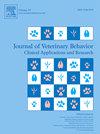Clinical relevance of rectal temperature measurement in cats showing marked signs of stress during routine veterinary examinations
IF 1.3
3区 农林科学
Q4 BEHAVIORAL SCIENCES
Journal of Veterinary Behavior-clinical Applications and Research
Pub Date : 2025-07-01
DOI:10.1016/j.jveb.2025.05.002
引用次数: 0
Abstract
Rectal temperature is a vital sign commonly measured during veterinary examinations. This procedure is known to be a major source of stress especially for cats. The purpose of this study was to evaluate the clinical relevance of rectal temperature measurement in healthy cats with signs of marked stress during a routine veterinary appointment. We hypothesized that since higher temperatures would be mostly found in cats with moderate to marked signs of stress, veterinarians would not change their clinical approach in these cats. A user-friendly Simplified Feline Stress Scale (SFSS) was developed. Its trial was the main objective of the pilot study (part 1) designed for 100 cats. Data surrounding temperature measurement in cats was documented (value of rectal temperature, time of restraint needed, and various factors related to cats and clinical staff such as age, sex and more) to evaluate potential associations with stress. Then, during a large-scale study (part 2) of 678 cats the previously validated SFSS was performed by clinical staff in 11 veterinary establishments concurrently with temperature measurements. The final portion of the study (part 3) was an online survey completed by veterinarians across the province of Quebec in order to document the reasons a high rectal temperature in a healthy cat might motivate a change of therapeutic plans. This study showed that veterinary appointments were associated with moderate to marked levels of stress in 62% of feline patients. Agreement between clinical staff-assessed and experienced observer-assessed SFSS scores during the temperature measurement was perfect in 74% of cases and even higher when clinical staff had received previous behavioral training. The majority of calm cats with low signs of stress were under 6 months of age. No change in the therapeutic plan was deemed necessary in stressed cats with an abnormal temperature if they were healthy. According to the online survey, 80% of veterinarians would not modify their treatment plan in such situations. The results of this study suggest that rectal temperature measurement in healthy cats during routine examination is not necessary and could be avoided in highly stressed feline patients.
猫直肠温度测量的临床意义在常规兽医检查中表现出明显的压力迹象
直肠温度是兽医检查时经常测量的生命体征。这个过程被认为是压力的主要来源,尤其是对猫来说。本研究的目的是评估在常规兽医预约期间有明显压力迹象的健康猫的直肠温度测量的临床相关性。我们假设,由于较高的体温大多出现在有中度到明显压力迹象的猫身上,兽医不会改变对这些猫的临床治疗方法。开发了一种用户友好的简化猫应激量表(SFSS)。它的试验是为100只猫设计的试点研究(第一部分)的主要目标。记录了猫的温度测量数据(直肠温度值、约束时间,以及与猫和临床工作人员相关的各种因素,如年龄、性别等),以评估与压力的潜在关联。然后,在对678只猫的大规模研究(第2部分)中,由11家兽医机构的临床工作人员在进行温度测量的同时进行了先前验证的SFSS。研究的最后一部分(第3部分)是由魁北克省的兽医完成的一项在线调查,目的是记录健康猫的高直肠温度可能促使改变治疗计划的原因。这项研究表明,62%的猫科动物患者接受兽医治疗与中度至显著的压力水平有关。在74%的病例中,临床工作人员评估的SFSS评分与经验丰富的观察者评估的SFSS评分之间的一致性是完美的,当临床工作人员之前接受过行为培训时,这一比例甚至更高。大多数表现出低压力迹象的平静猫都在6个月以下。对于体温异常的应激猫,如果它们是健康的,则不需要改变治疗计划。根据在线调查,在这种情况下,80%的兽医不会修改他们的治疗计划。本研究结果表明,在常规检查中,健康猫的直肠温度测量是不必要的,对于高度紧张的猫患者可以避免测量。
本文章由计算机程序翻译,如有差异,请以英文原文为准。
求助全文
约1分钟内获得全文
求助全文
来源期刊
CiteScore
3.50
自引率
16.70%
发文量
107
审稿时长
325 days
期刊介绍:
Journal of Veterinary Behavior: Clinical Applications and Research is an international journal that focuses on all aspects of veterinary behavioral medicine, with a particular emphasis on clinical applications and research. Articles cover such topics as basic research involving normal signaling or social behaviors, welfare and/or housing issues, molecular or quantitative genetics, and applied behavioral issues (eg, working dogs) that may have implications for clinical interest or assessment.
JVEB is the official journal of the Australian Veterinary Behaviour Interest Group, the British Veterinary Behaviour Association, Gesellschaft fr Tierverhaltensmedizin und Therapie, the International Working Dog Breeding Association, the Pet Professional Guild, the Association Veterinaire Suisse pour la Medecine Comportementale, and The American Veterinary Society of Animal Behavior.

 求助内容:
求助内容: 应助结果提醒方式:
应助结果提醒方式:


